ASPINA's pursuit of high efficiency - PAPR blower
-
Health & wellness
-
PAPR
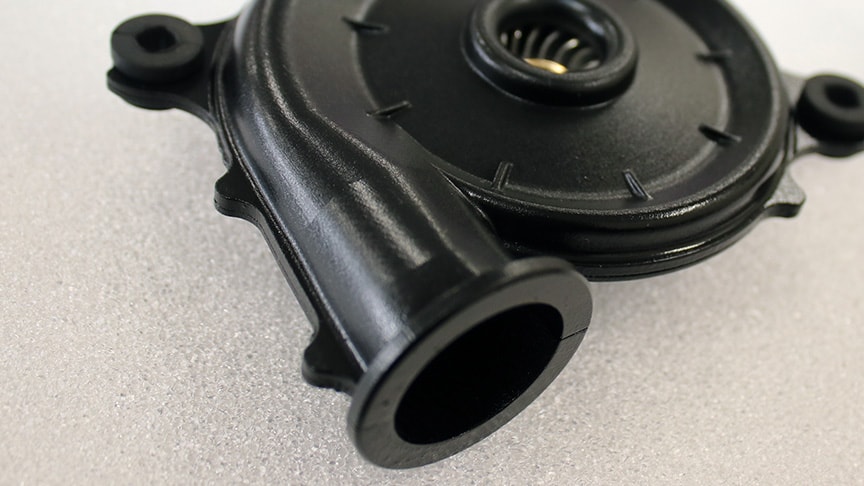
On being one step ahead in blower development
Small, light-weight, highly efficient, and low power consumption: to combine all of these features in a blower would be quite some achievement. Nevertheless, it is one that can realistically be brought about provided the various component parts can be reduced to their bare essentials and losses eliminated.
"One key to developing such an advanced blower is first to consider the electric motor, fan, casing, circuitry, and other components individually to build up an accurate understanding of where performance losses occur." So said, Hiroaki Usui, General Manager, Motor Technology Department, R&D Division as he began an explanation about the development of blowers for use in powered air purifying respirators (PAPRs), a type of respiratory protective equipment (RPE) that incorporates a built-in fan.
PAPRs are an essential item of safety equipment in biotech facilities or in dust-filled factories. They work by having the wearer don a mask and carry a battery-powered blower that draws air through a filter built into the mask. Accordingly, the blower not only needs to operate safely over long periods of time, it also needs to minimize things like weight, vibration, and noise so as to make the respirator easier to wear.
This consideration of what users need served as the starting point for a successful development by ASPINA of a new PAPR blower, one that incorporates technologies to make it smaller and lighter than previous models and provide a long battery operation time.
In doing so, the development team adopted a new approach that went beyond mere performance enhancement.
New approach and methodology for blower efficiency
"While previous blower models had been designed to work over a wide range of flow rates, this meant that they failed at what is really needed, namely to operate efficiently within the range of flows required in practice," explained Mr. Usui.
PAPRs reduce the stifling effect of wearing a filter by using a blower to draw in air and assist natural respiration. However, increasing the flow rate is not necessarily an improvement. What is needed, rather, is to provide a flow rate that matches the user's breathing. This led the development team to conclude that what makes for a good PAPR blower is a balance between a fan that delivers the ideal flow rate and a motor that works efficiently within the required range of flows.
They started by taking measurements from existing PAPR blowers, including flow, shaft torque, and static pressure, using these to provide a benchmark. The results indicated that peak performance efficiency for the PAPR blower did not occur within the range of flows being used. In other words, the existing blower suffered from a mismatch between its peak performance and the flows required in practice. Accordingly, ASPINA set about developing a blower that would be a major departure from its predecessor.
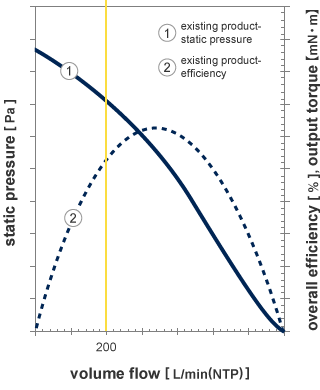 Benchmark measurement result of existing PAPR blowers
Benchmark measurement result of existing PAPR blowers
The volume of air needed to assist human breathing is less than 200L/min. To improve blower efficiency in this flow range, ASPINA utilized various simulation tools to conduct flow analyses, calculate circuit parameters, and evaluate pressure changes and other factors. This work revealed that losses were occurring in the casing as well as in the fan itself. Moreover, obtaining the desired operating points for the motor and fan respectively and then combining the two proved to be a difficult task. This was overcome by developing separate design tools for the motor and fan. In other words, rather than focusing solely on the motor, the development took account of compatibility between the different components, including the fan and casing.
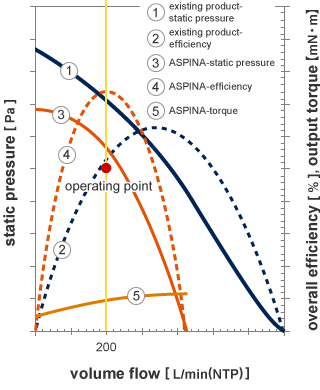 ASPINA's PAPR blower succeeded in being more efficient in the actual operating range of less than 200L/min
ASPINA's PAPR blower succeeded in being more efficient in the actual operating range of less than 200L/min
The resulting unit was approximately 40% smaller and lighter than its predecessor while also being more efficient in the actual operating range. The development also succeeded in lengthening the operating time under normal battery-powered conditions by more than an hour. This was the origin of the initial objective of making a PAPR blower that would significantly reduce the stress on the user.
Open innovation to acquire technology
Reducing fan diameter and weight required further improvements in design techniques. ASPINA has long had an active policy of seeking to build our strength by bringing in from outside those things that we lack. In the case of the blower development, this included working with universities and other research institutions to build prototype fans. This was followed up by an ongoing program of work aimed at enhancing design accuracy across all parameters, including blade diameter, blade height, and vane angle.
Two of the top priorities for the development team were to conduct benchmarking against the previous model and to include component-level analysis in the development process. The team successfully advanced blower technology by undertaking meticulous analyses to obtain a good understanding of the customer requirements and to be able to deliver what was needed. By drawing on a wide range of development techniques that encompassed the fan and casing as well as the motor, the blower development is a testament to the development capabilities of ASPINA and how it utilizes in-depth analysis to deliver the best possible products.
Further enhancements to blower efficiency to make people's life easier
ASPINA sees potential for utilizing the technologies acquired from the development of the PAPR blower in other fields that are subject to constraints of size, weight, power consumption, and so on. Medical equipment and vehicle air conditioning are two examples. In the future, ASPINA intends to make further progress on optimizing motors and fans and improving their performance with the aim of producing even better blowers that are smaller and lighter, have longer operating times, and are able to run quietly with low vibration.
Improvements in blower efficiency allow the products developed by customers to run for longer on each battery charge, thereby boosting the productivity of those product's end users. Similarly, smaller and lighter blowers give customers more flexibility in product design, helping them to achieve better appearance and lower cost.
ASPINA believes that its blowers will make work at factories and hospitals both easier and safer. Moreover, by making the company's blowers more suitable for use in numerous other applications, including home septic tanks and automotive uses, there is no doubt that this product is destined to meet the needs of many different users.
Exhibition information
-
Jun. 24, 2024
-
Apr. 12, 2024
-
Dec. 20, 2023
Related information
-
ASPINA's quiet medical-grade blower innovation revolutionizes CPAP therapy for sleep apnea sufferers
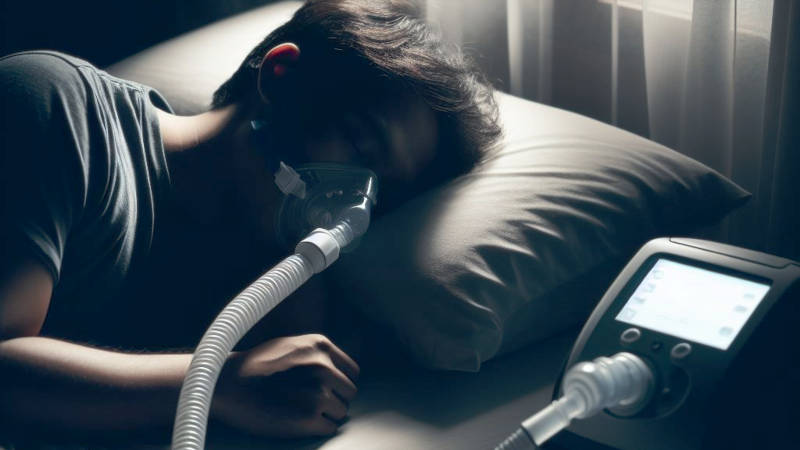
-
Leveraging cross-industry success: The advantage of ASPINA's medical ODM

-
ASPINA: The driving force behind the optimal motor selection for revolutionary medical machines
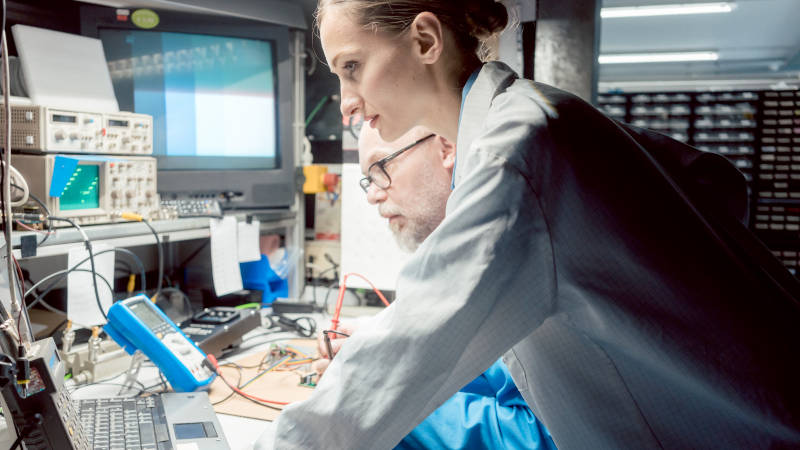
-
A journey of structural improvements: ASPINA's compressor revolutionizes portable medical devices










